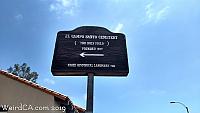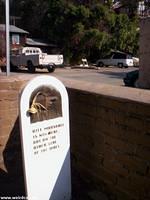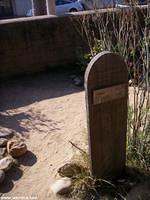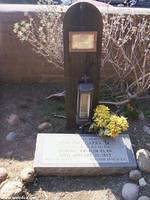El Campo Santo Cemetery
 2410 San Diego Avenue,
San Diego, California
92110
2410 San Diego Avenue,
San Diego, California
92110
This very old cemetery is located on the outskirts of Old Town in San Diego. Established in 1849, the cemetery is rumored to be the nexus for a surprising amount of spiritual activity, ranging from cold spots and misty figures to floating torsos of spirits, and, of course, vanishing spectral people. The cemetery was only used until 1887, but at least 477 people were buried there. Many of the gravesites have white fencing surrounding them, while others simply have rocks outlining their location, the grave marked by a simple piece of carved wood. The cemetery is located a little more than a block from the infamous and very haunted Whaley House. The current section that is enclosed by the wall is not the entire cemetery, and only surrounds a portion of the original cemetery. There are at least four active spirits, plus other phenomenon. The ghost most talked about is that of Yankee Jim Robinson, who in 1852 was arrested and hung where the Whaley House would eventually be built.
Unfortunately, the cemetery was bisected by a street car line in 1889, only like two years after the last body was put in the ground, and parts of the cemetery were later literally paved over in 1942 becoming San Diego Avenue. The need for roads had out grown the need for the cemetery, apparently, and the gravestones of those buried there were in an unfortunate location. Those buried underneath were simply ignored, now with a full lair of road above them, but they weren't gone, and in some cases it seems they were upset.
Cars parked on the street would often have problems starting. Their car alarms would often go off suddenly, and with no reason. In order to appease the spirits beneath the street, special marks have been placed in the pavement to show where the original graves are located. If you visit, look for them as you approach the cemetery. They are little metal circles that simply state "GRAVE" on them. There are several of them scattered both on the sidewalk and in the street. Additionally a plaque was placed in 1994, after ground penetrating radar was utilized in 1993 to locate more than twenty graves still under the street. Supposedly, another thirteen additional graves, many of them belonging to children, have been located under the pavement on Linwood Street as well. One of the more humorous headstones in the cemetery is that of Bill Marshall, which has an embossed hand pointing at the cemetery wall and simply reads, "Bill Marshall is not here. But on the other side of the wall".
Remembering the more than 20 men, women, and children who lie buried beneath San Diego Ave. Only assemblyman Edward L. Greene was exhumed and placed within the new boundary of El Campo Santo Cemetery.
These graves were discovered with the use of ground penetrating radar in 1993.
Rest in Peace
This plaque was placed by the Historical Shrine Foundation with funds from the San Diego Community Development Block Grant in 1994.
A lot of spiritual activity is said to occur here. One possible spirit is that of Yankee Jim Robinson. Jim Robinson, a tall man of about six feet, three or four inches, and sizable build, was arrested and tried for Grand Larceny, for supposedly stealing San Diego's only row boat. On August 18th, 1852, Robinson was found guilty by a jury, a jury that interestingly, and probably unfairly, contained the two owners of the boat which he had stolen. He was sentenanced to be hung for his crime. On September 18th, 1852, he was hung nearby at the site that would soon, in about three short years, contain the Whaley House. The hanging of Yankee Jim involved him being hung from some gallows that were barely taller than him, as, at the time, he was tall for the era. As a result it took a while for him to slowly strangle to death as he dangled, after being pulled from the cart they had him standing on. Rumor has it, that the coffin they buried him in was also for a more average, and thus shorter, man, which led to them having to break his legs to fit him in it, after his execution. Another rumor states that his godfather was a local deputy sheriff and actually gave the signal for his execution!
Antonio Garra, a Native American and chief of the Cupenos tribe, is also buried here. In late 1851, Garra led an uprising of Native Americans against the people of San Diego; the revolt is now called the Garra Uprising. San Diego levied taxes against the Native Americans, who not having the right to vote, found this practice of taxing unfair, as they were denied representation. The uprising, unfortunately for Garra did not go well, even though he tried to bring in other Native American tribes. Garra was eventually captured in a trap laid for him by Chief Juan Antonio of the Chuillas, when Garra was trying to convince him to join the rebellion. Antonio instead made a deal, captured Garra and turned him over. Garra was found guilty of leading the uprising, and was tried for treason, murder, and robbery.
He was made to stand before his freshly dug grave, and executed by a firing squad. On the day of the execution, January 10th, 1852, while standing before his open grave, Garra was requested of Padre Juan Holbein to ask for pardon from the large crowd that had gathered to witness the execution. Eventually, Garra stated, "Gentlemen, I ask your pardon for all my offenses, and expect yours in return." Afterwards the firing squad shot him and his body fell backwards into his grave. Several visitors have had odd experiences standing in the position where Garra did all those years ago. As a side note, Thomas Whaley of the Whaley House was apparently a member of the firing squad. You can also see "wanted posters" and other information on Garra in the First San Diego Courthouse Museum, located nearby in Old Town.
Anita Gillis, who might have died of scarlet fever at age nine, is said to haunt both the cemetery and the Whaley House. Her grave often has toys, books, and even stuffed animals decorating it, left by those who visit the cemetery. She is said to occasionally be found hiding under the table in the dining room of the Whaley House. Lilian Whaley actually wrote of her funeral procession when Anita died. "The child lay in a tiny white coffin ... six little girls dressed in white with wreaths on their heads carried the table". It is said that Anita, and perhaps other ghost children still haunt the cemetery. Regardless of if this is true or not, if the ghost does, indeed, exist, she gets plenty of toys to play with. My daughter, Tiffany, was fascinated by Anita's grave and literally played around the gravesite.
In 1865, Juan Mendoza, at 46, was shotgunned in the back by Colonel Cave Johnson Couts. We need to pause here to discuss the sheer number of ghosts that Couts may be responsible for. First he was another juror on the Yankee Jim Robinson trial, and thus one of the men who sentenced Yankee Jim to death. Second, he was involved in the trying of the Garra uprising as the Judge Advocate and found Garra guilty of murder and robbery. Third, he was married on April 5th, 1851 to Ysidora Bandini, daughter of Juan Bandini. It is said that she literally fell off her home's balcony, while trying to watch a parade, and into the arms of Couts. She outlived her husband, but is said to still haunt the adobe of her father's, now called the Cosmopolitan Hotel, also in Old Town. And finally, fourth we have Juan Mendoza, a rancher who was shot in the back by Colonel Cave Couts. As the story goes, Mendoza worked for Couts on one of his ranches. Couts claimed that Mendoza threatened his life. Apparently this means that Couts now had the right to "stand his ground and kill him", which he did, by shooting him in the back with a shotgun, literally in broad daylight. Couts was even tried and found not guilty by the jury!
Another ghost lurking outside the cemetery is that of a woman in a low cut dress, long skirt, and bandanna. She stands outside the gate of the cemetery, and it is believed that she was a prostitute who was refused burial inside the cemetery, forever wanting to be buried with everyone else. A ghost of a gravedigger has also been seen numerous times.
Other interesting gravesites include the Native American Melchior who was born in 1770 and lived for 97 years until 1867! Rosa Serrano de Cassidy still has one of the few remaining original headstones in the cemetery, although it is now cracked and has been laid down flat in order to preserve it. Thomas W. Tanner ran an acting troupe that actually performed on the second floor of the Whaley House! The house clearly did him in as he unfortunately died seventeen days after the play opened. Near the gate is Jesus, a 25 year old Native American who died from a blow to the head while being "completely drunk". The priest literally commanded that he be buried near the gate to the cemetery. You should take the time to read some of the other narratives posted near the gravesites. Several are extremely interesting and colorful.
Supposedly the local businesses and residents pooled their money and had the graveyard and surrounding area exorcised in 1996. It is reported that spiritual activity has declined some since then. Regardless, stories still persist of apparitions being seen in the cemetery, several often being mistaken for Old Town park employees dressed up in period costumes. Many of the ghosts are partially visible and usually float above the ground.
El Campo Santo (The Holy Field)
El Campo Santo once included the adobe chapel on Conde Street, in which was buried Jose Antonio Aguirre and where funeral services were held for Maria Victoria Dominguez Estudillo, Cave Johnson Couts, and many distinguised early San Diegans. Between 1849 and 1897, 477 persons were buried in these grounds. Antonio Garra was the most eminent of many Native Americans interred here. A number of graves were relocated after 1874. A street railway bisected the cemetery in 1894. The wall around this portion was built in 1933. Restoration has continued to the present.
California Registered Historical Landmark No. 68
First Registered December 6, 1932. Plaque placed by the State Department of Recreation in coorperation with the San Diego City Department of Parks and Recreation and Squibob Chapter, E. Clampus Vitus, August 6, 1994.
Follow WeirdCA.com!
Closest Weird
Whaley House
0.11 Miles Away
San Diego, California
The Cosmopolitan Hotel
0.27 Miles Away
San Diego, California
El Fandango Restaurant
0.31 Miles Away
San Diego, California
Outside References:
- Ghost Hunter's Guide to Los Angeles (2007) by Dwyer, Jeff, p: 197 - 199
- Haunted Places: The National Directory (2002) by Hauck, Dennis, p: 67
- Visiting Haunted Southern California (2005) by Hilber H. Graf, p: 113 - 115
- San Diego Specters: Ghosts, Poltergeists and Phantastic Tales (1999) by Lamb, John, p: 51 - 56
- Ghosthunting Southern California (2012) by Richards, Sally, p: 27 - 34
- Ghosts of the California Missions (2011) by Senate, Richard, p: 12 - 13
First Created: 2012-07-11
Last Edited: 2020-10-24






